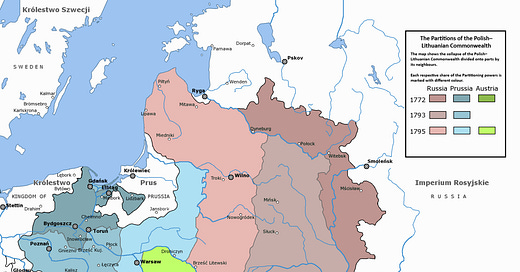At eight pages, this chapter is the shortest by far. Why?
Blitzkrieg.
The Germans were just fundamentally better prepared both than Germans in World War I and also than any of their opponents in 1939 and 1940.
As Shirer puts it:
Horses against tanks! The cavalryman’s long lance against the tank’s long cannon! Brave and valiant and foolhardy though they were, the Poles were simply overwhelmed by the German onslaught.
Consequently, the battles did not last very long. Shirer begins chapter 18 with General Halder notation in his diary that “the enemy is practically beaten.”
And the Russians then also got in on the action. After a series of diplomatic exchanges, the Soviets rolled into Poland on September 17, over two weeks after the Nazis had invaded. They met the Germans at Brest Litovsk, where exactly 21 years earlier, the new Bolshevik government had signed a peace treaty to end World War I on the eastern front.
Stalin, however, did not trust his German partners. In the end, he decided to not take over all the Polish territory that had been promised the USSR but instead to take the Baltic states (Estonia, Latvia, and Lithuania). Ribbentrop flew to Moscow at the end of September 1939 and the Germans and Russians drew up new borders for eastern Europe.
Shirer notes, “Hitler fought and won the war in Poland, but the greater winner was Stalin, whose troops scarcely fired a shot.”
Hitler accepted what was the first bad deal for him, but only because he wanted to free himself to focus on Britain and France in the West.
The Backstory on Poland
The relationship of Poland to its Germanic and Russian neighbors is a long and complicated story. I tried (and failed) to get a historian friend who studies Poland to come on the podcast to talk about Polish national identity and its complicated relationship with the Germans and the Russians over the centuries.
I’ll try to give the gist here, though. Poland existed throughout the medieval period, sometimes in conjunction with Lithuania. It converted to Catholic Christianity, but later than Western Europe. It was thus different from the Germans and Austrians in that it was a Slavic nation, but also different from Russia in that it was Western Christian (Catholic) and not Eastern (Orthodox).
Poland was not always the strongest country in its region. The 18th century was particularly tough. Between 1772 and 1795, Poland was systematically divvied up between Russia, Prussia, and Austria, even as it managed to establish Europe’s first modern constitution in 1791.

For much of the 19th century, Poland didn’t exist. It was only recreated then after World War I. In the meantime, many Polish intellectuals and artists lived abroad, especially in Paris. So, for instance, Chopin and Adam Mickiewicz, the great Polish writer, lived much of their lives in Paris.
After the end of World War II, Poland was recreated. But tensions with its Slavic and Germanic neighbors continued, especially given the ethnic makeup of certain regions.
When the Nazis and Soviets then decided to split Poland in 1939, they were acting in accordance with longstanding European tradition.

As I mentioned in my previous post, there is a Netflix documentary “Hitler and the Nazis: Evil on Trial.” If you are interested in American reporters who covered Nazi Germany and have found this read along interesting, then please check it out, since it includes William Shirer’s radio broadcasts from the 1930s and 1940s.
Not Entirely Shameless Self-Promotion
I kind of hate self-promotion.
And I’m certainly not very good at it. My philosophy has always been that if I produce something good, it will eventually be recognized. I don’t want to pressure people into rewarding my work if it doesn’t deserve it.
However, I’ve come to the conclusion that this is not the best strategy for 21st century success. So here a quick plug (with a great deal of shame to be completely honest):
Virtually everything I produce here is free. However, I do have a few paid subscribers, which conveys a few benefits, including full video of the podcasts and some more personal engagement.
So do consider upgrading your subscription if you’ve enjoyed anything I’ve produced here (and don’t hate me…)
Alternatively, maybe you have friends who might be interested in reporters’s coverage and historians’ perspectives on fascism last century. If so, please consider passing along the link to this Substack to them.
Topical Posts
Podcast ep. 1: The Man, The Myth: Hitler in American Culture
The Problems with the German Character Explanation of the Nazis
Podcast ep. 2: Why are Dictators (and Techno-monarchs) Appealing?
Podcast ep. 3: Interview with a 20th Century War Correspondent: Jon Randal
If You’ve Fallen Behind on the Reading, This Post is For You
Who was William L. Shirer? — part 2 (The Nightmare Years 1934-1940)
Podcast ep. 4: The Exhilaration & Peril of Covering the Nazis (with Prof. Michael Socolow) (Video, Audio)
Podcast ep. 5: What American Reporters Saw That Others Didn't (with Prof. Deborah Cohen) (Video, Audio)



